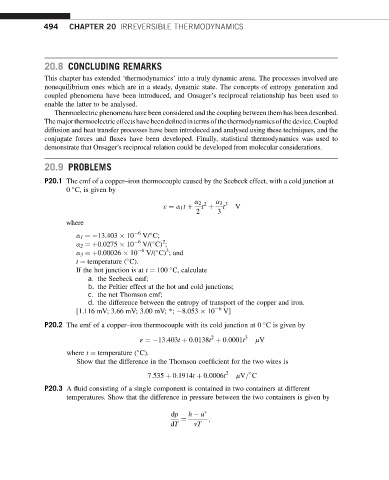Page 502 - Advanced thermodynamics for engineers
P. 502
494 CHAPTER 20 IRREVERSIBLE THERMODYNAMICS
20.8 CONCLUDING REMARKS
This chapter has extended ‘thermodynamics’ into a truly dynamic arena. The processes involved are
nonequilibrium ones which are in a steady, dynamic state. The concepts of entropy generation and
coupled phenomena have been introduced, and Onsager’s reciprocal relationship has been used to
enable the latter to be analysed.
Thermoelectric phenomena have been considered and the coupling between them has been described.
Themajorthermoelectric effectshavebeendefinedintermsofthethermodynamicsofthe device.Coupled
diffusion and heat transfer processes have been introduced and analysed using these techniques, and the
conjugate forces and fluxes have been developed. Finally, statistical thermodynamics was used to
demonstrate that Onsager’s reciprocal relation could be developed from molecular considerations.
20.9 PROBLEMS
P20.1 The emf of a copper–iron thermocouple caused by the Seebeck effect, with a cold junction at
0 C, is given by
a 2 2 a 3 3
ε ¼ a 1 t þ t þ t V
2 3
where
a 1 ¼ 13.403 10 6 V/ C;
2
a 2 ¼þ0.0275 10 6 V/( C) ;
3
a 3 ¼þ0.00026 10 6 V/( C) ; and
t ¼ temperature ( C).
If the hot junction is at t ¼ 100 C, calculate
a. the Seebeck emf;
b. the Peltier effect at the hot and cold junctions;
c. the net Thomson emf;
d. the difference between the entropy of transport of the copper and iron.
[1.116 mV; 3.66 mV; 3.00 mV; *; 8.053 10 6 V]
P20.2 The emf of a copper–iron thermocouple with its cold junction at 0 C is given by
2
ε ¼ 13:403t þ 0:0138t þ 0:0001t 3 mV
where t ¼ temperature ( C).
Show that the difference in the Thomson coefficient for the two wires is
2
7:535 þ 0:1914t þ 0:0006t mV= C
P20.3 A fluid consisting of a single component is contained in two containers at different
temperatures. Show that the difference in pressure between the two containers is given by
dp h u
¼ ;
dT vT

